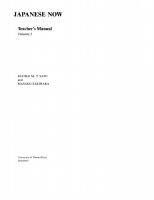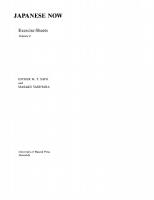Japanese Now: Text — Volume 3 9780824846411
Japanese Now is a popular four-year learning program used in numerous American secondary schools and universities. The f
124 86 17MB
English Pages [256] Year 2023
CONTENTS
ACKNOWLEDGMENTS
INTRODUCTION
NOTES
INTRODUCTORY LESSONS
INTRODUCTORY LESSON 1 Geography of Japan
INTRODUCTORY LESSON 2 Kanji —Chinese Character
LESSONS 1-10
LESSON 1
LESSON 2
LESSON 3
LESSON 4 HtS
LESSON 5
LESSON 6
LESSON 7
LESSON 7
LESSON 9
LESSON 10
APPENDIXES
SUMMARY OF GRAMMAR
LIST OF KANJI
GLOSSARY
ABOUT THE AUTHORS
Recommend Papers

- Author / Uploaded
- Esther M. T. Sato
- Masako Sakihara
File loading please wait...
Citation preview
JAPANESE NOW
JAPANESE NOW Text Volume 3
ESTHER M. T. SATO and
MASAKO SAKIHARA
University of Hawaii Press Honolulu
©
1 9 8 7 UNIVERSITY OF HAWAII PRESS
ALL RIGHTS RESERVED MANUFACTURED IN THE UNITED STATES OF AMERICA
92 91 90 89
5 4 3 2 1
TAPES TO ACCOMPANY THIS TEXT ARE AVAILABLE FROM UNIVERSITY OF HAWAII PRESS 2 8 4 0 KOLOWALU STREET HONOLULU, HAWAII 9 6 8 2 2 PUBLICATION OF THIS BOOK HAS BEEN ASSISTED BY A GRANT FROM THE JAPAN FOUNDATION.
Library of Congress Cataloging-in-Publication Data (Revised for vol. 3) Sato, Esther M. T., 1915Japanese now. Maps on lining papers (v. 1) Contents: v. 1. Text—v. 2. Text— v. 3. Text. 1. Japanese language—Text-books for foreign speakers—English. I. Shishido, Loren I., 1946II. Sakihara, Masako, 1935. III. Title. PL539.3.S28 1982 495.6'82421 81-23142 ISBN 0-8248-0773-1 (vol. 1) ISBN 0-8248-0795-2 (vol. 2) ISBN 0-8248-1042-2 (vol. 3)
CONTENTS Acknowledgments
vii
Introduction
ix
Notes
xi
Introductory
Lessons
1
Lesson 1 Geography of Japan
3
Lesson 2 Kanji (iH^p)—Chinese Characters
8
Lessons
11
Lesson 1
* J
;
W
U
—
J
Lesson 2
J^M
32
Lesson 3
0 it
57
Lesson 4
I I © — ifet
74
Lesson 5
&
E
B
—
1
3
94
Lesson 6
^CfP
110
Lesson 7
^cPM
130
Lesson 8
)£J!
143
Lesson 9
iU'H
157
Lesson 10
171
Appendixes
187
Summary of Grammar
189
ListofKanji
196
Glossary
199
v
ACKNOWLEDGMENTS
materials. Publication of this book was assisted by a grant from the Japan Foundation. To our colleagues in the College of Education, especially the Department of Curriculum and Instruction and the Curriculum Research and Development Group, we would like to express our deep appreciation for their interest and continuous support. We wish to say thank you as well to Mrs. Ayako Nishizawa, Mrs. Nobuko Iwamoto, and Mrs. Kinue Freitas for their assistance as resource persons. And again we say mahalo to the University of Hawaii Press for their guidance throughout the publication process.
We would like to thank the students, teachers, and administrators of the Hawaii State Department of Education who have given us continued support in our efforts. Their assistance and encouragement have helped inspire us to complete this Volume 3 of the Japanese Now series. We wish also to express our special thanks to the University of Hawaii Foundation for financial support and to the Cultural Foundation on Promoting the Traditional Costume of Japan in Hawaii for a generous monetary donation. Together these donations have enabled us to maintain a graduate assistant and to record in Japan the tapes that accompany our text
vii
INTRODUCTION
Through an educational and cultural tour of J a p a n , Volume 3 presents a variety of experiences to help expand the student's knowledge of Japan and its natural beauty, its economy, and its cultural treasures, as well as the complex speech styles of the Japanese language. In the presentation of the lesson material, the formal, literary style of writing is introduced as a contrast to the colloquial style presented in Volumes 1 and 2. Unlike the conversations in the previous volumes, which reviewed only the lesson content, the conversations in this volume supplement the material in the Reading Selections.
Aside f r o m providing for review and reinforcement of the materials covered in previous lessons, each of the ten lessons in Volume 3 helps the students to increase their understanding of Japanese, to include acquiring a better grasp of the language patterns and grammar. This knowledge, coupled with more extensive vocabulary and kanji learning, facilitates reading comprehension, writing skills, and ease of conversation. As in Volumes 1 and 2, each lesson includes a Reading Selection and Dialogue followed by new Vocabulary, Reading Practice, G r a m m a r Notes, Drills, Kanji, and Exercises.
IX
NOTES 1.
To facilitate the recognition and reading of kanji for comprehension, many new kanji are introduced in the Reading Selections. However, the number to be learned for reading and writing is limited to those that are in more frequent use. In the t H ? section of each lesson, both the on and kun readings are given for each new character; the on reading is given in the katakana script and the kun in hiragana. Examples of words (both single characters and compounds), taken from the lessons in this volume, are provided for each on and kun reading, along with furigana (the kana placed above a kanji for pronunciation) and English meaning. A dash ( — ) in place of the on or the kun reading indicates that there is no on or no kun reading for that kanji. Examples for on or kun reading are not given if the kanji has not been introduced in this or preceding volumes.
2.
There are two categories of Japanese verbs: transitive (vt) and intransitive (vi). Transitive verbs take an object with the particle £ . Intransitive verbs do not take the particle , except for verbs of motion, as in ^ i f o T < tz$ I*. (This was introduced in Volume 2.) The following are examples of transitive and intransitive verbs. Note the differences in their use in the paired sentences below. &j£3(vi) AftS(vt)
M^s(vt)
(vi)
ftt
(vt)
M ^ (vi) ft
3 (vi)
Examples: a)
ttibt
Lfco
(vt)
I started a savings account. a')
lBftl
7 y * f r
tfet T









